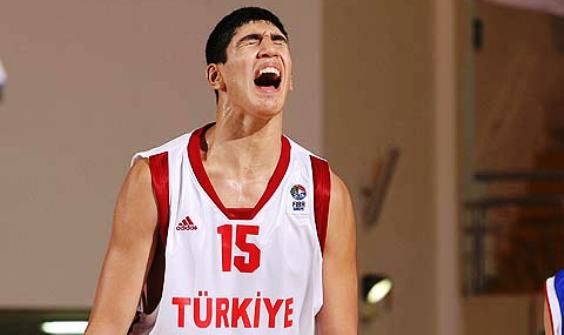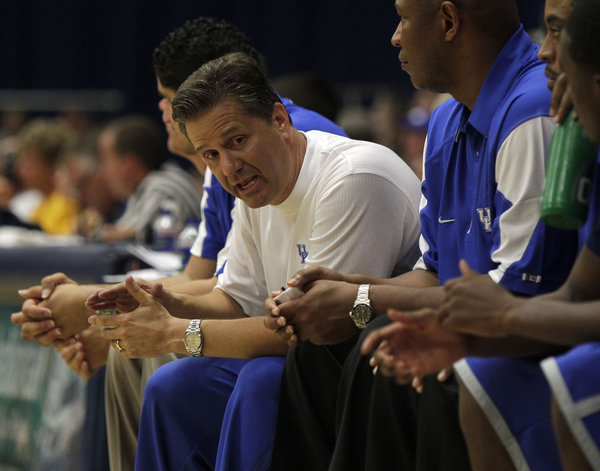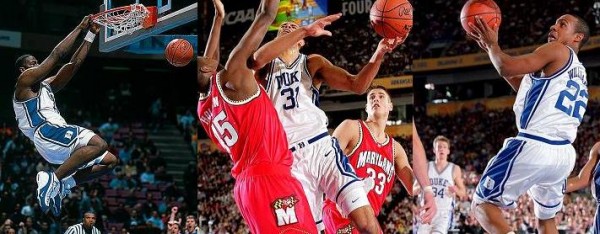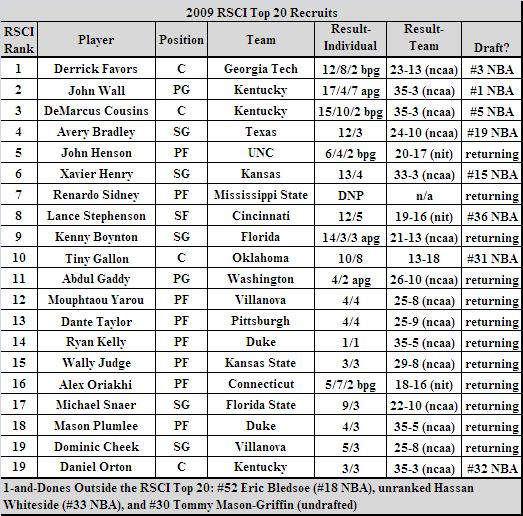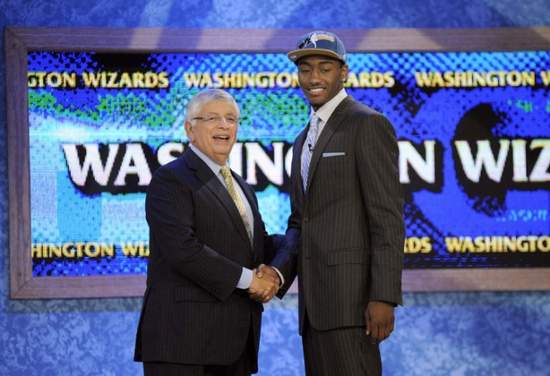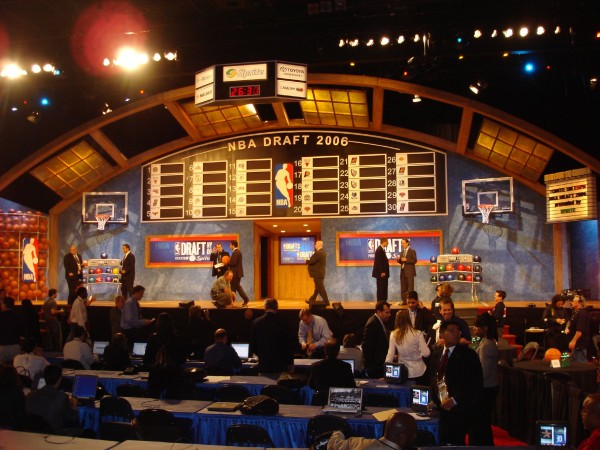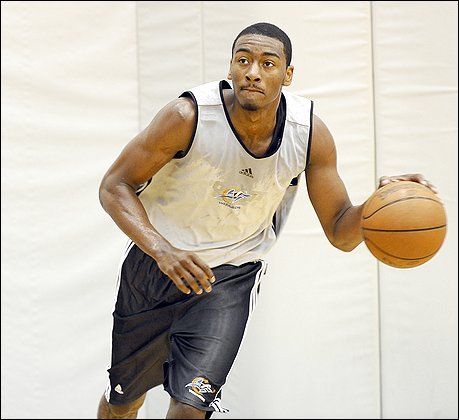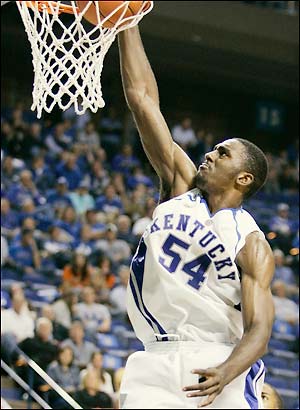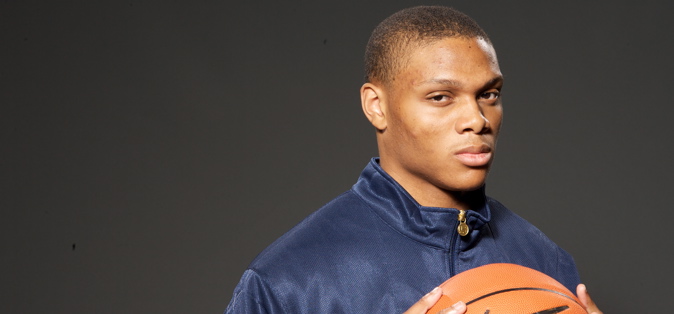Posted by zhayes9 on August 27th, 2010
Zach Hayes is a editor, contributor and bracketologist at Rush the Court. To see the entire group of 2010-11 Class Schedules, click here.
After dissecting a trio of Big 12 teams in prior weeks, more and more elite programs are releasing their 2010-11 schedules to the masses. Let’s continue with Kentucky, a squad that reloaded following the departure of an astounding five first round draft picks.
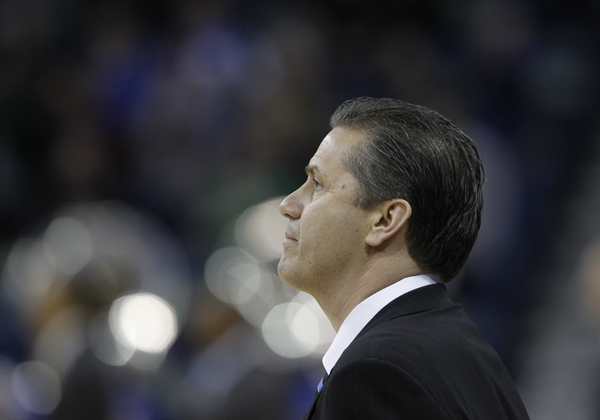
With so much turnover, Calipari has another tough coaching job on his hands
Team Outlook: A fan base as rabid and fanatical as Kentucky’s surely awaited this week’s announcement with tremendous anticipation. Big Blue Nation has expectations for their Wildcats that perennially surpass any other program in the nation. Their point guard and this April’s #1 overall pick in the NBA Draft, John Wall, will be replaced by Brandon Knight, whose high school accolades and ranking matches those of his predecessors under John Calipari. If deemed eligible by the NCAA, Enes Kanter will fill the post presence left by the ultra-productive DeMarcus Cousins. Similarly to Kanter, Terrence Jones spurned Washington and headed to Kentucky, a 6’9 wing very capable of matching the offensive production provided by Eric Bledsoe a season ago. The key word for Kentucky and Calipari since he took the helm: replenish. And if Knight, Kanter and Jones are history next April, three more top-ten recruits will fill the void. It’s a tall task for Knight and Kanter to match the contributions of Wall and Cousins, two of the top three players in the sport last season. Still, with such talent abounding, a wide open SEC, and the true dribble-drive offense back into high gear, to expect a giant step back from Big Blue and underestimating the coaching prowess of Calipari would be a grave mistake.
Non-Conference Schedule Rank (ranked 1 thru 10, 10 being the most difficult): 7.5. A program with the visibility and significance of Kentucky should challenge themselves at every chance. Forced out of necessity more than choice to load up in November and December at Memphis, Calipari has utilized that same strategy in Lexington. The potential is there to face fellow powerhouses at least in terms of college basketball history: North Carolina, Michigan State, Louisville, Indiana, Notre Dame, Washington and Oklahoma, although these teams remain at varying degrees of competitiveness. Kentucky will surely attract an enormous contingent to Maui where they could face a top-ten team in the semifinals in Washington and a top-two team in the finals, Michigan State. North Carolina is still working its way back up to elite status following last year’s NIT berth, but the young Wildcats’ trip to the Dean Dome won’t be any sort of cakewalk. The same theory applies to Louisville on New Year’s Eve, the next chapter of one of the fiercest rivalries the sport knows. A matchup with possible NCAA squad Notre Dame should also prove competitive. Kentucky gets everyone’s best shot, and it’s no relief for Calipari that up to seven non-conference contests will be either on true road or neutral floors.
Cupcake City: Two notable cupcakes travel to Lexington when Mississippi Valley State and Coppin State make the trip for what should be 40-point blowouts, but other than that Calipari did a solid job limiting the scrubs. East Tennessee State returns their top three scorers from an NCAA Tournament team that was blown out in the first round by, you guessed it, Kentucky. I’m not saying the Wildcats are vulnerable to lose to the Buccaneers, but they will not be a total walkover. Winthrop rode a Big South Cinderella run to an NCAA bid and is on the slate. Boston University with John Holland and Jake O’Brien is halfway decent, while a Maui tune-up in Portland against the rebuilding Pilots will provide a raucous atmosphere. Last season, Kentucky did struggle a bit early in the campaign against Miami (OH), Stanford and Sam Houston State while Calipari determined roles and rotations for a plethora of new players. If the same holds true a year later, Portland and BU could be pesky opponents.
Toughest Early Season Test: It’s far from a guarantee that Kentucky downs Washington in the Maui semifinals. After all, the Huskies return the majority of their backcourt led by Isaiah Thomas, Venoy Overton and Abdul Gaddy with a frontcourt anchored by Matthew Bryan-Amaning and a talented newcomer in Terrence Ross. Plus, they should have plenty of motivation to knock Kentucky down a few pegs following the Kanter and Jones situations that have been rehashed continuously. If the Wildcats can survive Washington, and I have a sneaking suspicion they will, Michigan State awaits in the final if the Spartans can knock off Connecticut or Wichita State (unless they pull a Virginia against Chaminade). The Spartans return their entire Final Four squad with the exception of Raymar Morgan and Chris Allen. Containing Kalin Lucas is baptism by fire for green Brandon Knight, while wing Darius Miller may have the unenviable task of chasing around three-point bomber Durrell Summers. The Spartans will likely be ranked number two in the nation behind Duke at this point. Win or lose, the learning experience will certainly be valuable for the young Wildcats.
Read the rest of this entry »
| 2010-11 Season Preview, rtc class schedule
| Tagged: abdul gaddy, alabama, alex tyus, arkansas, auburn, bobby maze, boston university, brad tinsley, brandon knight, brett nelson, brian williams, bruce pearl, chaminade, chandler parsons, chris allen, connecticut, courtney fortson, darius miller, demarcus cousins, devan downey, durrell summers, east tennessee state, enes kanter, eric bledsoe, erving walker, florda, georgia, indiana, iowa, isaiah thomas, jake o'brien, jamychal green, jeff peterson, jeff taylor, john calipari, john holland, john jenkins, john pelphrey, john wall, jp prince, kalin lucas, kenny boynton, kentucky, louisville, lsu, marshawn powell, matthew bryan-amaning, memphis, miami (oh), michigan state, mississippi, mississippi state, notre dame, oklahoma, ole miss, portland, raymar morgan, renardo sidney, rod odom, rotnei clarke, sam houston state, scotty hopson, scotty thurman, south carolina, stanford, tennessee, terrence jones, terrence ross, tobias harris, travis leslie, trevor releford, uconn, uf, unc, uva, vanderbilt, venoy overton, virginia, washington, wayne chism, wichita state
Share this story

































